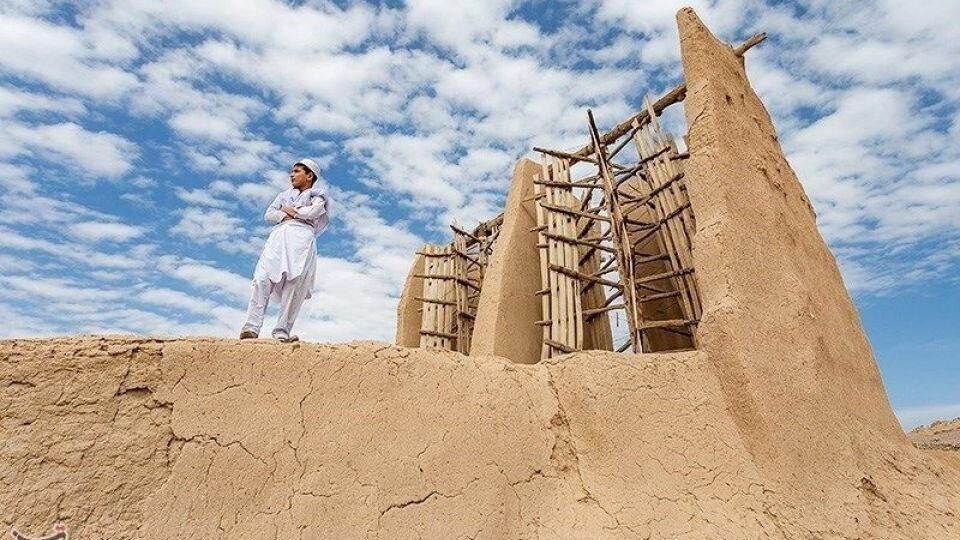Tehran – Several centuries-old windmills (locally called Asbads) located in the ancient town of Sangan, northeast Iran, have been inscribed on the country's national list of cultural heritage.
Asbad is a smart system to grind grains, a technique that goes back to ancient times when the people living in the eastern parts of Iran, in an attempt to adapt themselves to nature and transform environmental obstacles into opportunities, managed to invent it.
“Historical Asbads in the city of Sangan (which is located in Khaf county of Khorasan Razavi province) have been registered under the number 3396 in the list of Iran's national heritage,” said Mahmoud Togharaei, who presides over the Registration and Preservation Office for the province’s historical monuments.
These Asbads, located in the southeast of Sangan, consist of 10 windmill structures that have remained linearly connected from the Qajar era to the present day, the official said.
Togharaei said Asbads are relatively tall adobe structures constructed in the past along the path of seasonal or local winds. “Utilizing the power of the wind and converting it into rotational force, they were connected to millstones, grinding wheat and other grains. Asbads were mainly constructed in the eastern regions of Iran, often along the path of the 120-day winds of Sistan."
He said the structure of Sangan's Asbads represents a two-story windtower. “The upper story containing wooden vanes is known as the 'par-khaneh' (wind catcher), and the lower story housing the stone mill is termed as the 'as-khaneh' (mill house).”
“Asbads, as symbols of sustainable, creative, and unique architecture adapted to the regional climate, held a vital role in people's lives in the past. They have attracted global attention and are introduced as an Iranian element, standing on the brink of global registration."
The official emphasized: "This intangible cultural heritage, with its valuable architectural and technical-engineering features, embodies cultural, social, and economic aspects of past generations. They are considered as valuable heritage from the knowledge of ancestors in the sustainable and appropriate utilization of climate and environmental conditions for future generations."
"Following the national registration of these monuments, essential actions toward their restoration, preservation, and revitalization must continue, positioning them as cultural tourist attractions, open to the scrutiny of heritage enthusiasts."
To date, more than 2,700 historical artifacts in Khorasan Razavi have been registered in Iran's national heritage list.
Glimpses of ancient Iranian windmills
The development of Asbads took place due to the scarcity of water resources and continuous 120-day winds, which annually sweep through the east and southeast of the Iranian plateau from late May to late September. In fact, wood, mud, and brick were the main construction materials for the two-story windmills.
Britannica says the earliest known references to windmills are to a Persian millwright in 644 CE and windmills in Seistan [Sistan], Iran, in 915 CE.
Iran seeks UNESCO recognition for arrays of its ancient windmills that can be found in the provinces of Sistan-Baluchestan, South Khorasan, and Khorasan Razavi.
The Ministry of Cultural Heritage, Tourism, and Handicrafts has almost completed the necessary preparations for a chain of ancient vertical-axis windmills; however, the documentation and mapping works have not been completed yet.
The documentation and mapping projects entail various architectural plans, cross-section geometry, photogrammetric photographs, and their proprietorship. Official reports suggest all documenting and mapping stages are being carried out based on the UNESCO standards and criteria.
According to the UN cultural body, Robert Forbes, a technology historian, stresses the point that the Islamic era windmill was the invention of Iranians. He writes: "This invention which was initially an exclusive device for Iran and Afghanistan, turned into an important source of energy all over the Islamic territories in the 12th century, and not only it was used for the grinding of grains and operation of water pumps, but also the chopping of sugarcanes and other purposes.
Moreover, the UNESCO website says that such vertical-axis windmills were taken to China during the Mongol reign.
Furthermore, the know-how of windmills was taken to other Islamic territories and was used in Egypt as the main source for the chopping and grinding of sugarcanes. In the 11th century, windmills reached Spain, the Islands of the Aegean Sea, and Portugal.
Constructed of clay, wood, and straw, those ancient gears which are inherited from preceding generations, are perched on a cliff overlooking the village, milling grain for centuries.
According to the latest official data, a total of 374 Asbads have been identified so far mostly in the eastern wing of the country, but not all of them in faultless conditions.
Technically speaking, unlike European windmills, the Iranian design is powered by blades arrayed on a vertical axis in which the wind power is directly translated down without the need for any gears found on the horizontal-axis mills.


No comments:
Post a Comment